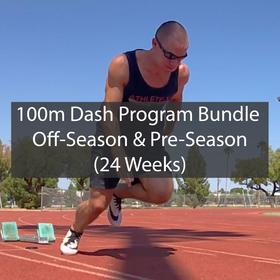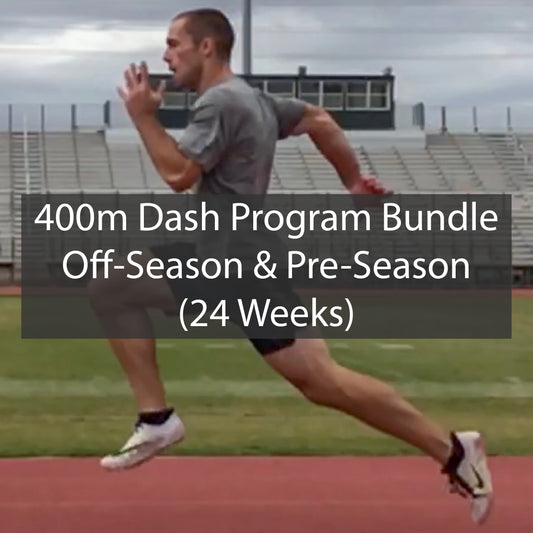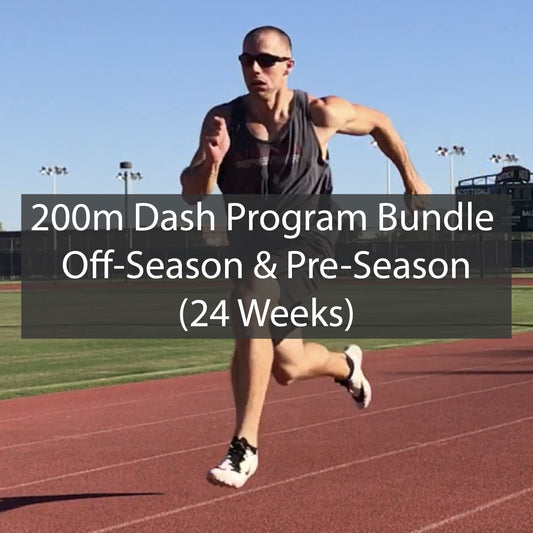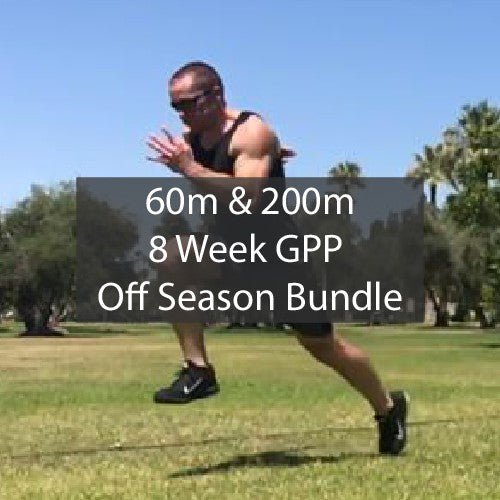Frequently Asked Sprinting Questions
If you have questions about sprinting, strength training, or being an athlete, this is the page for you! Below are questions that have been asked by our followers, subscribers, and customers.
During Sprinting, Backside Mechanics Includes Which Motions?
Backside mechanics typically refers to leg motions during sprinting which takes place with the legs behind the midline of the body.
The three motions commonly associated with backside mechanics include:
- Hip extension.
- Knee extension.
- Ankle plantar-flexion.
Athletes who exhibit excessive backside mechanics can be identified by movements such as:
- The swing leg staying in hip extension as knee flexion occurs.
- The bottom of the foot being pointed up at the sky near peak knee flexion.
- Excessive forward lean and anterior pelvic tilt.
- The foot crashing forward at contact, aka positive foot speed.
When training for speed, the energy system focus is?
The energy system focus when training for speed is anaerobic, meaning it is not dependent on oxygen to produce ATP.
In reality, oxygen is used when you sprint, but it is not the primary source of energy due the rapid demands of sprinting.
Earlier in the sprint, the creatine phosphate or phosphagen system will dominate, shifting toward alactic glycolysis and eventually lactic glycolysis.
Why can plyometric training also help in improving one's speed?
Plyometric training has beneficial effects on the nervous system, on tissue qualities, and on the athletes skill level.
Plyometric training can improve the use of elastic tissues, improving one’s ability to bounce and move with fluidity and explosiveness.
Plyometric training can improve active muscle stiffness, joint stiffness, reactive strength, vertical jump, and more!
Other Sprinting Questions
- Question: Should I focus more on plyometrics or lifting along with sprinting during the off-season?
-
Answer: Athletes should utilize a combination of both jumping exercises as well as strength training exercises in their off season training program. True plyometrics should not be performed until the athlete is at a very high level, but various hopping exercises and multiple jump exercises can be performed virtually from day one.
- Question: What should a beginner sprinter focus on if they are trying to improve from 12 seconds down to 11 seconds or faster?
-
Answer: Regardless of an athlete's current time, the general focus of training will be the same - they should sprint, lift weights, and perform different types of jumping exercises. Athletes who are running in the 11 or 12 second range can focus on more simple approaches to training, and will be more likely to see improvement regardless of how well their training program is built.
A blend of faster sprints (acceleration/speed development) as well as slower sprints (tempo endurance) can be performed earlier in the year, extending the distance of the fast sprints such that eventually some of the acceleration & speed development work turns into speed endurance training.
Strength training for these athletes can be simplistic, such as 3-6 reps per set and 50-75% of their maximum load. Use exercises like full range of motion squats, deadlifts, rows, overhead press, bench press, etc. to develop a good base of strength. As time goes on, these lifts can progress into lighter and faster power oriented lifts, and/or to heavier, more maximum strength oriented lifts.
- Question: Should you stop weight training if you have a tendon injury such as patellar tendonitis, achilles tendonitis, etc.?
-
Answer: I cannot prescribe rehab as I am not a PT, but what I would did if I were in that situation would be to reduce the loaded and focus on rehab oriented exercises. For example you can do eccentric leg extensions where you use both legs to raise the load, and one leg to lower the load slowly.
Blood flow restriction training would likely be a good idea to utilize as well, because this can help with pain reduction while also improving the response your body gives to the low load strength training being performed for rehab.
- Question: How can I improve the last 80 meters of a 200 meter dash race?
-
Answer: If your basic fitness levels are sufficient (you can easily perform tempo endurance runs between 100m and 300m per run at around 70% effort), then I would advise focusing on maximum effort sprints around 150 meters, extending the distance as you see improvement.
You can work up to going beyond 200 meters, but I think this should only be the focus once you see improvement in the shorter sprints. If for whatever reason you do not see any improvement from doing 150 meter sprints (or a similar distance), then you can try doing over-distance work such as 250 meters, 300 meters, etc.
- Question: Should sprinters training once or twice per day?
-
Answer: This depends on your life as a whole. If you are a full time athlete with no other major responsibilities, you can likely plan your entire day around training, which would allow for the proper rest and nutrition intake to allow for multiple sessions per day. For the average person who goes to school, has a job, or has a family to take care of, they are better off focusing on one good training session per day.
Life stress adds to the aggregate stress load of a training program, so you need to work with what you have rather than forcing training in when it doesn't make sense in a holistic sense. I would rather train once per day and be able to consistently repeat this over time, rather than doing two sessions per day for a couple months and eventually getting burnt out.
- Question: Can sprinters lift weights before their sprinting workouts?
-
Answer: Yes they can, but they need to be aware of how much tissue damage is created as a result of the strength training sessions, as well as how the body responds with muscle tone (tension at rest) and how fatigued the athlete gets. Lifting sessions before sprinting workouts should utilize less time under tension and an overall lower workload than if the lifting were being performed after the sprinting session.
Your best bet is to experiment by trying lifting before and after your sprinting workouts, and seeing if you feel better, worse, or the same. See if your times are changed, if anything hurts, etc. If you feel good and your performance isn't destroyed by lifting first, then you can be fairly certain it is OK for you to do. If you lift and then feel horrible every sprinting session, obviously you need to rework the schedule.
- Question: Is a closed fist or open hand better when sprinting?
-
Answer: I would go with whatever allows you to be relaxed but powerful at the same time. For example if you grip your fist too tightly, you'll likely generate too much arm tension and your arm swing will be slow or restricted. Experiment with an open hand, relaxed hand, and closed fist, and see what looks best as well as what produces the fastest times.
- Question: What can I do to prevent shin splints?
-
Answer: The two factors that will have the greatest impact on shin splints are how you contact the ground, and how much your legs are chronically loaded in your training program.
When running and sprinting, we want the foot to be traveling at a zero or even a negative horizontal velocity when it contacts the ground. If it is moving forward when it contacts the ground, the leg will have to decelerate before it can apply force down and back into the ground, and this braking motion will cause a lot of stress on the lower legs. The forward crashing foot contact is very common, and very detrimental to both performance and health.
Once an athlete has optimized their ground contact qualities, they should then look at how often they are sprinting, jumping, or doing other tasks which load the lower leg heavily. If an athlete sprints and jumps every day, they will eventually experience chronic overload in the lower leg and they will start to feel the pressure & soreness that comes along with shin splints. If you ease into higher frequency training, such as sprinting 2 times per week, then 3, then 4, over the course of many months, you will be better off than if you jumped straight into a 6x per week program after sitting on the couch for 2 months.
- Question: How can I solve plantar fascitis?
-
Answer: While it will vary depending on your situation, typically a mixture of calf/ankle/foot strengthening exercises will help, as well as learning to use your whole foot when contacting the ground at slower speeds.
Similar to the question about shin splints, you need to make sure that you are contacting the ground properly as well as making sure you are not chronically overloading the legs in your sprint training program. If you're always on your toes, you will stress out the plantar fascia and will end up in pain. After a period of time where you reduce or eliminate running & jumping, you can reintroduce running at slow speeds as you work on contacting the ground using your entire foot and progress speeds from there.
Focus on isometric and eccentric exercises for the calves & feet, so you can strengthen the tissues at longer muscle lengths and without causing much pain. Progress slowly and you will eventually be in a better place. Also, consider using blood flow restriction training to accelerate recovery and reduce pain.
- Question: How can you improving pushing during acceleration and block starts?
-
Answer: There are a few ways to approach this.
First of all, your starting stance needs to be set up in such a way that you are able to push downward and backward into the ground. If your shins are too vertical or too horizontal, you will run into problems. Being too vertical sends you up, and being too low will make you crash, also forcing you to stand up to prevent falling. Optimize your stand to the lowest shin angle you're able to handle without stumbling.
Second, focus on pushing straight down into the ground while maintaining a forward oriented torso. This article on acceleration sprinting mechanics might be helpful. If you keep your torso forward and strike under your body, you will naturally project outward down the track.
Another thing to experiment with are resisted sprints. Heavy sleds can help teach athletes how to produce larger forces rather than rushing the early acceleration, while lighter sleds can help athletes work on the transition from the start into later acceleration. Weight vests over vertical resistance which will help teach you produce vertical forces in acceleration.
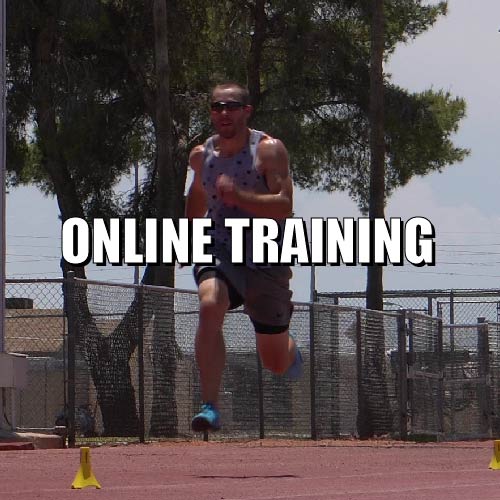
Online Training Group
Get workouts sent to your phone to help you get stronger, sprint faster, and jump explosively.
Sprint Training Articles
View all-
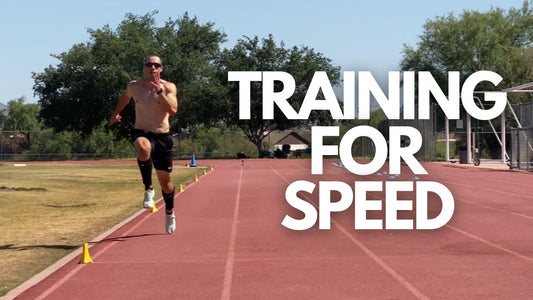
Training For Speed - Methods, Progressions & Ti...
Speed training is fundamentally the primary way to train in order to sprint faster. Social media influencers and coaches throw the term speed training around loosely, when in reality it...
Training For Speed - Methods, Progressions & Ti...
Speed training is fundamentally the primary way to train in order to sprint faster. Social media influencers and coaches throw the term speed training around loosely, when in reality it...
-
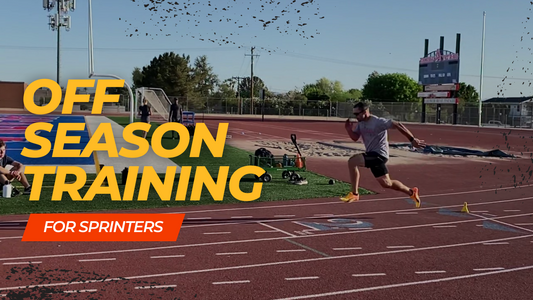
How Should Sprinters Train In Their Off Season?
After a long season of training and competition, many sprinters find themselves wondering what they should do once the season has come to a close. Some continue to train hard,...
How Should Sprinters Train In Their Off Season?
After a long season of training and competition, many sprinters find themselves wondering what they should do once the season has come to a close. Some continue to train hard,...
-
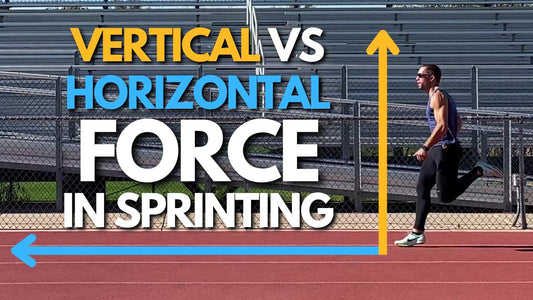
Force Production In Sprinting | Is Vertical Or ...
In discussions surrounding sprint performance, coaches and researchers have debated whether vertical force or horizontal force is more important for running fast. While many will pick a side and claim...
Force Production In Sprinting | Is Vertical Or ...
In discussions surrounding sprint performance, coaches and researchers have debated whether vertical force or horizontal force is more important for running fast. While many will pick a side and claim...
Sprint Training Programs
-
100 Meter Dash Training Program Off-Season & Pre-Season Bundle
Regular price $47.00 USDRegular priceUnit price / per$99.00 USDSale price $47.00 USDSale -
400m Dash Off-Season & Pre-Season Training Program Bundle
Regular price $47.00 USDRegular priceUnit price / per$95.97 USDSale price $47.00 USDSale -
200m Dash Off-Season & Pre-Season Training Program Bundle
Regular price $47.00 USDRegular priceUnit price / per$95.97 USDSale price $47.00 USDSale -
Indoor Off Season Bundle - 60 Meter & 200 Meter Dash GPP Training Programs
Regular price $62.00 USDRegular priceUnit price / per$78.00 USDSale price $62.00 USDSale



